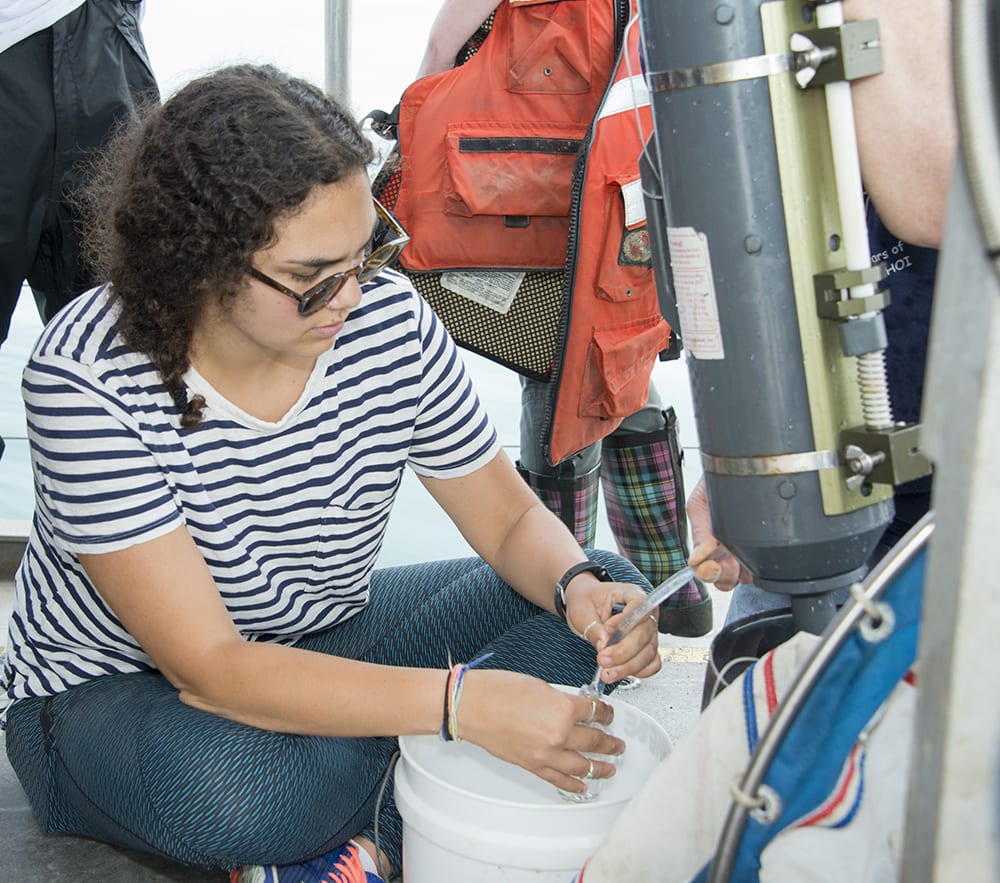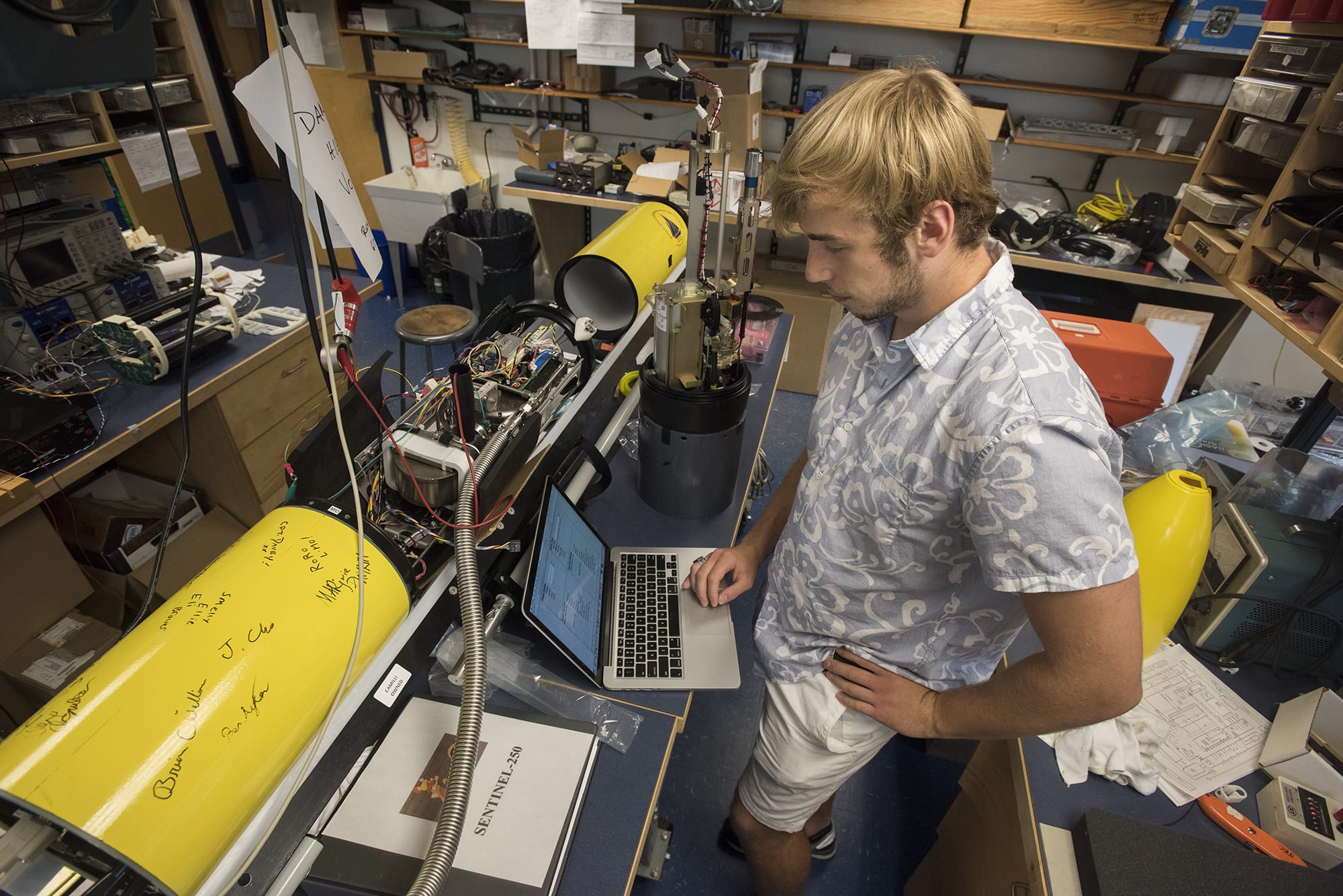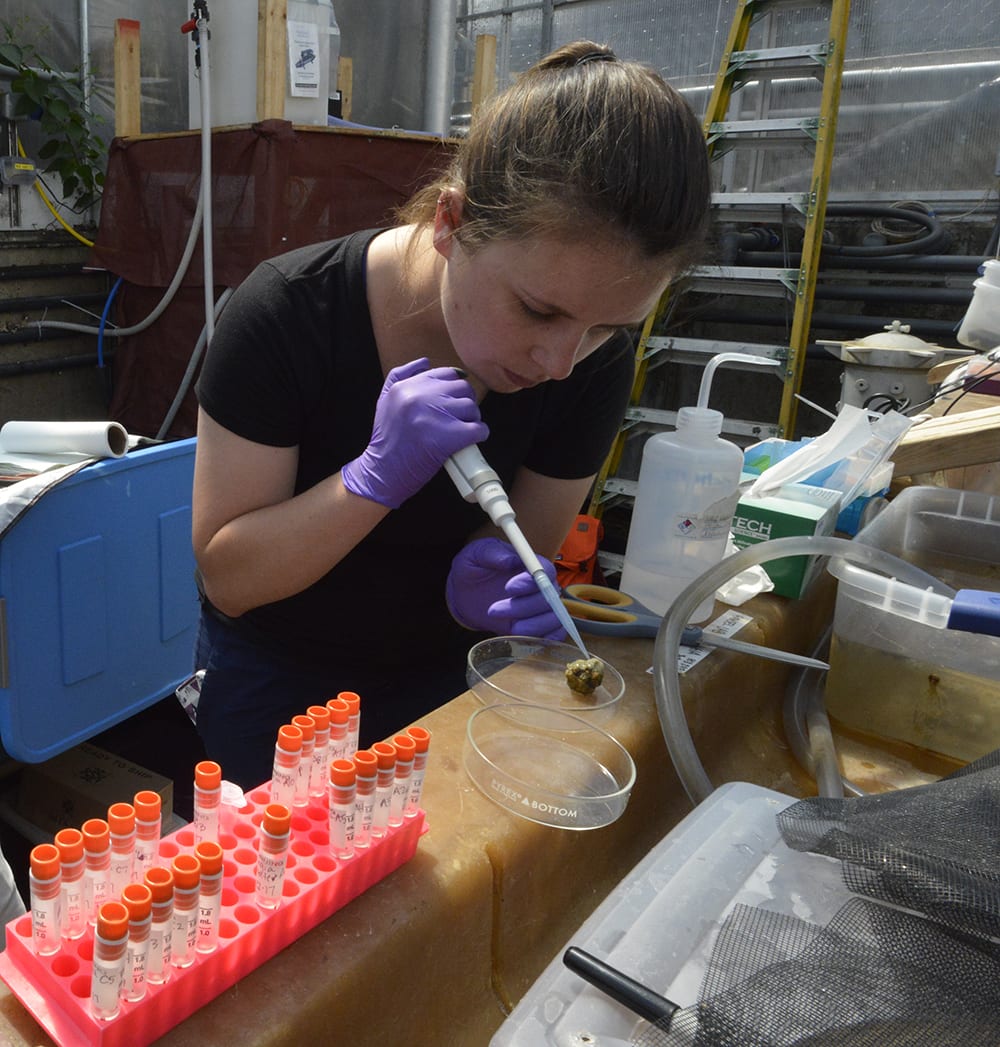2017 Research Highlights

Mapping Food Webs with Stable Isotopes
Julianna Renzi, University of Arizona
Trophic ecology is essential to the functioning of marine ecosystems. Understanding the basics of who eats what can help inform scientists about the ecological ramifications of overfishing species, introducing new ones, and how food webs are changing over time. The desire to answer these questions drew me to Dr. Simon Thorrold’s Fish Ecology lab at WHOI, where I worked on developing a new method for studying trophic ecology: Compound-Specific Stable Isotope Analysis of Amino Acids (CSIA-AA).
While stable isotopes have been a staple of ecological research for decades, CSIA-AA has the potential to provide a higher-resolution picture of carbon flow through food webs. It leverages the fact that primary producers, such as corals and macroalgae, have unique carbon signatures in their essential amino acids, which are retained by the organisms that consume them. A fish who eats coral will have the specific coral “fingerprint” in its muscle and we can use mixing models to discern what portion of its diet comes from each carbon source.
However, we don’t know how specific these “fingerprints” are. I was initially drawn to CSIA-AA for its potential to determine how fish partition macroalgal species, which compelled me to spend my summer looking at whether individual genera of macroalgae—not just macroalgae as a single group—have unique carbon fingerprints. This project sent me snorkeling around Woods Hole where I collected macroalgae, learned how to identify different species, and fell in love with the sight of colorful macroalgal communities swaying with the waves. When I wasn’t face down in the water I was in lab, where I learned how to analyze samples using CSIA-AA—from freeze-drying specimens, to extracting their amino acids, to running them through a state-of-the-art mass spectrometer.
Despite my fervent enthusiasm for macroalgae and CSIA-AA, which I hope to work with in graduate school, the summer wasn’t only amazing because of the time I spent working on my project. When I look back on my three months at Woods Hole I’m overcome with appreciation for the inspirational set of peers I met through the program, the exposure I received to top-tier oceanographic research, the amazing program coordinators that made this summer possible, my brief stint on the Biology softball team, the opportunity to go shark tagging with a graduate student in my lab, the supportive environment created by everyone at WHOI, and all of the day-olds I consumed from Pie in the Sky. And, of course, I’m grateful for algae.

Enhancing the Capabilities of Autonomous Underwater Vehicles
Zachary Duguid, MIT
Bathed in total darkness, where even the most determined photons are denied entry, the deep ocean is home to entire ecosystems of bizarre critters. Although it covers roughly 70 percent of Earth’s surface, the ocean remains largely unexplored. In fact, it is estimated that humans have explored less than five percent of the Earth’s largest feature (NOAA). Though it is largely unexplored, the ocean plays a critical role in vital processes such as the regulation of Earth’s climate. Protecting us from the ozone-demolishing greenhouse gas, the ocean greedily ingests tremendous amounts of CO2 via surface-dwelling phytoplankton. Therefore, by better understanding the vast complexities of the ocean, we will be more prepared to achieve longevity for humanity. To unlock the secrets of the ocean, we turn to autonomous underwater vehicles (AUVs). Without bearing the risk of losing human life, AUVs can confidently navigate the most dangerous regions of the ocean to make novel discoveries.
During my Summer Student Fellow experience, I worked with Rich Camilli in the Deep Submergence Laboratory to enhance the capabilities of a particular AUV: the Slocum Glider. The Slocum Glider is an AUV that is specialized for long range research scenarios. Equipped with a low power mass spectrometer that monitors the presence of subsea hydrocarbons, the Slocum Glider conducts ocean sampling missions for weeks at a time. To maximize the achievable range of the glider, it is essential to maximize the total power capacity contained within the vehicle. To do this, the old battery system that consisted of non-rechargeable Alkaline C cells has been replaced with a new system consisting of rechargeable Lithium Ion cells. The new Lithium Ion batteries are lighter and more powerful compared to their Alkaline counterparts. To assist the integration process of the new battery system, I created a graphical user interface (GUI) that monitors relevant battery state variables such as current draw and voltage. By monitoring battery state information, we are able to diagnosis battery malfunctions as they arise and appropriately update the mission to handle such malfunctions. Also, I developed a battery chassis to physically hold the individual batteries within the confines of the glider hull. To do so, I utilized computer aided design (CAD) and 3D printing methods, which allowed for rapid prototyping. Finally, I also got involved with a particular form of path planning for the Slocum Glider by considering velocity-optimized paths subject to ocean current conditions. Through this research, we discovered a rather counterintuitive result that when in the presence of favorable ocean currents, it is necessary to reduce propulsive power in order to maximize range.
Through my WHOI Summer Fellowship Experience, I was exposed to many facets of systems engineering in the research setting. As a result, I gained many new skills and I was exposed to many fascinating research areas. I am very grateful for the opportunity to conduct research at WHOI and I am excited about the future of ocean-monitoring autonomous robots.

Reactive Oxygen Production by Corals
Shavonna Bent, Johnson State College, VT
Coral reefs have become a hot topic issue over the last few years in the face of climate change (pun intended). Many people are working to better understand these ecosystems, so they can be better preserved. However, growing in the cold waters of New England, is another coral species, one that may prove to be a valuable model system to understand interactions between coral and their symbionts. Astangia poculata, the Northern Star coral, can live with or without algal symbionts. This relationship is of particular interest, as tropical coral cannot survive very long without their resident algae.
With the guidance of Drs. Amy Apprill and Colleen Hansel, I studied the production of reactive oxygen species (ROS), specifically, the superoxide molecule, by A. poculata and in the members of its holobiont. In tropical coral, internal ROS is associated with detrimental effects such as coral bleaching. However, externally, little is known about the production of the superoxide molecule. Drs. Hansel and Apprill have previously studied ROS production at the surface of several tropical corals and found no correlation with bleaching status, and more thermally tolerant species appear to produce more ROS. This presents an interesting conundrum to the traditional story of ROS being a negative molecule in the coral ecosystem.
A. poculata was selected for study as it can thrive without algal symbionts, allowing us to separate the contributions of ROS from the coral and algae. We also eliminated the surface mucus layer microbiome determine if microbes on the coral surface contributed to ROS production. We found no significant differences between any of the corals, regardless of algal symbiosis or presence of surface microorganisms. However, by testing two bacterial species isolated from the surface of A. poculata, we found that microbes living on the surface produce superoxide at biologically relevant levels, in vitro. This suggests that A. poculata controls the production of external ROS. Determining the mechanism of control could yield insight as to how tropical coral control superoxide levels in their immediate environment, and what role this may play in ecosystem health.
Throughout the summer I learned invaluable skills working with two amazing mentors. My experience extended much farther than the lab however, as I was invited into the research community, to attend lab barbecues, sail for the first time, meet for dinner with the Chilean producers of a film about the resurgence of blue whales, and make friends that I still talk to almost every day. Being surrounded by dedicated and passionate people inspired me to push my boundaries, both in research and personally. I cannot speak highly enough of the SSF program, nor the people that run it, nor the community at Woods Hole.
